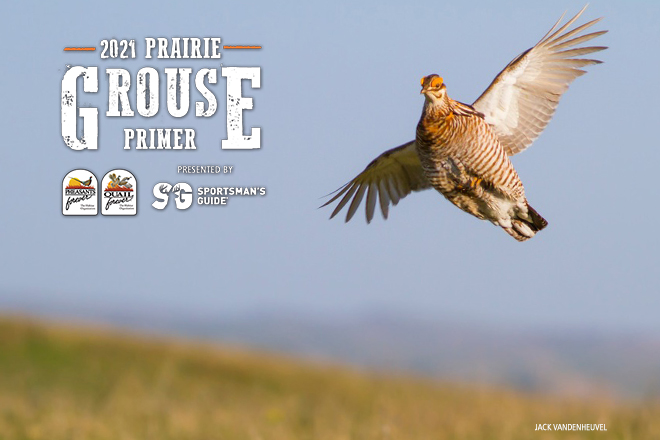
Drought may dim NoDak sharptail prospects, but birds found will be in bunches
By Anthony Hauck
Following a banner sharp-tailed grouse season in 2020, the drought of 2021 and its effects have nicked away at prairie grouse populations heading into fall, where the next campaign opens Saturday, September 11.
In what may be the coming season’s tired, drought-stricken refrain, these native upland prizes can still be had – and may even be plentiful in pockets – but those discoveries will require more in the way of digital research, scouting and boot leather.
Last year, 19,971 grouse hunters bagged 86,965 sharptails, numbers padded by a healthy population of birds plus the Covid-19 outdoor recreation boom.
Busts inevitably follow such booms, the question is always how soon. Too soon, in this case.
“It’s going to be a tougher season”, says Rachel Bush, Pheasants Forever’s State Coordinator and Ag Program Manager in North Dakota. “Cover has become pretty limited, with what’s out there having been grazed hard or hayed.”
Jesse Kolar, Upland Game Management Supervisor with the state’s Department of Game and Fish, said these drought reactions, more than the drought itself, rule out chances for a successful, widespread late-summer hatch.
“It’s warm and dry, which is exactly what you want to keep chicks alive. And we have abundant insects,” Kolar said, “But grouse relying on those second and third nesting attempts in July and August are losing nests to cattle and haying. And ultimately, if hens don’t get enough moisture, they just stop laying eggs.”
Kolar is a conservationist and therefore an optimist, so he is able to poke holes of light through what could be a real gloomy grouse outlook.
First, Kolar is encouraged by the insect production, a major difference when comparing this drought to its predecessor in 2017, because those bugs offer broods their lifeline.
Second, though he knows the results from the annual roadside brood survey, due out in early September, will undoutbedly be lower than last year, he says survey conditions are designed for wet, humid mornings, and such days were nonexistent during this year’s count. Because grouse rely on shrub habitat, he says it’s also quite possible the birds are keyed in on those areas, and would therefore not likely be counted.
And third, the drought’s deficit is not equal. Kolar says the sky’s spigot was kinder to some areas more than others, including Dickinson, where he’s located.
Kolar says hunters who find the locations where rains filled gauges a bit more, where more hoppers hopped, and where there’s shrubby cover will find better bird numbers: “They’ll be bunched up in what limited cover remains, and the people that find those spots could find some fast action.”
Emily Spolyar is Precision Ag and Conservation Specialist with Pheasants Forever in western North Dakota, and says scouting at the Little Missouri National Grasslands – the largest grassland in the country – bears this out. “It’s a night and day difference between the areas that got a bit of moisture and the areas that did not. I’ve seen big, healthy broods in areas where there’s been a bit of moisture.”
The biologists urge hunters to check drought and precipitation maps, notably the U.S. Drought Monitor, in advance of their trips. The sharptail country standout in this initial view is the oval area from Killdeer down to Hettinger. It’s still in drought, just not as bad as elsewhere.
Until precipitation or winter arrives, hunters in North Dakota must also be aware of wildfire risk and possible restrictions, which could include no travel beyond primary roads. This safety measure, while inconvenient, may further dwindle the ranks of uplanders willing to, in an already grind of a year, wear through even more boot leather. If you’re willing to walk two-tracks, more for you.
Sharptailers, as much as any other hunter in North Dakota, have long taken advantage of North Dakota’s rule that allowed hunting on unposted lands. That rule hasn’t changed, but what has is landowners can now electronically post their properties in lieu of, or in addition to, traditional physical posting. Translation: lands can be posted physically, digitally, or both. Check out North Dakota’s app online to see electronically posted lands.
North Dakota’s sharp-tailed grouse season, along with the season for Hungarian partridge, opens Saturday, September 11, and continues through Sunday, January 2.
Anthony Hauck wears out two soles’ worth of boot leather each fall chasing sharptails.